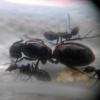The intensity of lighting and other factors, among which are temperature, relative humidity, safety from disturbances such as wind, rain, and predators, and proximity to water and food are evaluated by ants when choosing a nesting location. For example, ants may establish their nest on a liquid feeder filled with water if their intended formicarium nesting area becomes unfavorably dry, regardless of lighting or other factors.
If you imagine a sterile setup where all things are equal, with a designated foraging area and nest on opposite sides, then keeping the foraging area side relatively brighter will generally cause the ants to prefer the other side as their nest. Lighting is all about relativity, and if the baseline ambient lighting is at a comfortable level for viewing, then the ants will be less disturbed by small changes. If the baseline is complete darkness, then even small changes to our perception of visible lighting will have a profound impact on the ants' natural alarm response to an intrusion.
My understanding was the heat from the light is what gets them to move, no so much the light it's self.
It is a combination of visible light, UV light, and excessive heat which produces an alarm response and emergency nest relocation. The ants can sense all these things, and have evolved to avoid them when seeking shelter.






















